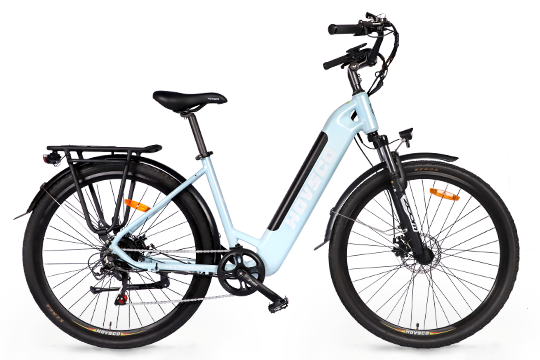How To Ship An Electric Bike, And How Much Does It Cost To Ship A Bike?

Biking is a great way to get exercise, save money on transportation costs, and reduce your carbon footprint. But what do you do if you don't live in a place where it's easy to bike to work or school? Or what if you're going on a long trip and don't want to take your bike with you? One option is to ship your electric bike. This blog post will tell you how to ship an electric bike and how much it costs to ship a bike. We'll also give you some tips for packing your electric bike safely for shipping. So whether you're moving across the country or just taking a vacation, read on for tips on shipping your electric bike!
How To Ship An Electric Bike?
You may already know that you can't just ride your electric bike onto a plane. Even if you disassemble it, some airlines won't let you bring your e-bike on board with you. Plus, as a new e-bike owner, you don't want to learn on a clunky old regular pedal-only bicycle while traveling! The best way to transport your new (or used) e-bike is via cargo shipping. Cargo shipping means your bike will be treated like any other piece of luggage and will travel in the belly of an airplane or big rig truck. Most importantly, since cargo shipments aren't considered aircraft-only flights, they allow both standard bikes AND e-bikes to fly at no extra charge! If you're planning on shipping your electric bike, there are a few things you need to do in order to make sure it arrives safely at its destination.
1) Deflate The Tires:
One mistake many e-bike owners make is not deflating their tires prior to shipping. When you inflate your tires, they can get very stiff. Not only is that dangerous while riding because they're harder to control, but it also means they'll take up more space in your crate! If your tires are extra high, be sure to deflate them before boxing them up manually. Also, consider using paper or Styrofoam wedges between each tire for added space savings!

2) Remove The Battery:
Most e-bike batteries are removable, and we recommend taking them out before shipping. Not only will this help prevent any potential damage to the battery during transit, but it will also save you some money on shipping costs. The lithium-ion batteries that power most e-bikes are considered "dangerous goods" by the DOT and IATA, which means they'll incur an additional fee if you don't remove them prior to shipping.
3) Disconnect The Motor:
If your e-bike has a removable motor, it's a good idea to disconnect it before shipping. This will help prevent any potential damage to the motor during transit. Plus, it will make your e-bike lighter and easier to handle when you're packing it up for shipping.
4) Secure Any Loose Parts:
Before you box up your e-bike, make sure all the loose parts are secured. This includes the battery (if it's not already removed), the motor (if it's not already disconnected), and any other removable parts. You don't want these parts bouncing around inside the box during shipping, so make sure they're securely fastened.
5) Wrap The Frame In Bubble Wrap Or A Shipping Blanket:
To help prevent scratches or other damage to your e-bike's frame, wrap it in bubble wrap or a shipping blanket. This will provide a layer of protection against bumps and scratches during transit.
6) Place The Bike In A Cardboard Box Or Hard-Sided Case:
Once you've wrapped the frame and secured all the loose parts, you're ready to place your e-bike in a box or hard-sided case. If you're using a cardboard box, make sure it's sturdy enough to support the weight of your e-bike. You may also want to consider using packing peanuts or other filler material to help protect your e-bike during transit.
7) Seal The Box Or Case With Packing Tape:
Once you've placed your e-bike in its box or case, seal it up with packing tape. Make sure all sides are securely taped. You don't want any holes in your box that could let water or other outside elements into your package during shipping!

8) Mark Your Package As Fragile And Handle With Care:
Finally, make sure you mark your package as fragile and handle it with care. This will help ensure that your e-bike arrives safely at its destination. It's also a good idea to include your name, address, phone number, and email on all sides of your box or case so that whoever is handling it knows who it belongs to.
9) Ship Your E-Bike:
Once you've got everything packed up in a sturdy box or hard-sided case and marked properly for shipping, take it down to your local UPS store or FedEx office for shipping. If you're not sure where to find one near you, just Google UPS Store or FedEx Office along with your zip code. They'll have all sorts of information about locations and contact info online!
How Much Does It Cost To Ship A E-Bike?
The cost of shipping an e-bike will depend on a few factors, including the size and weight of your bike, the distance it's being shipped, and whether you're using a shipping company or a private courier service. In general, expect to pay anywhere from $50 to $100 to ship an electric bike domestically and around $200 to $300 to ship internationally. Of course, these prices can vary depending on the size and weight of your e-bike, so it's always best to check with your chosen shipping company for an accurate quote.
Conclusion
When it comes to shipping an electric bike, it's important to choose a reliable and insured shipping company. UPS and FedEx are two of the most popular shipping companies for electric bikes, but there are plenty of others out there as well. Just do some research and find one that you're comfortable with! Ensure to insure your shipment for the full value of your bike, and keep all tracking information in case something goes wrong. Shipping your e-bike doesn't have to be a stressful experience with a little planning and care!






Leave a comment